Monday, February 27, 2006
More Lviv
I'm not a big goer-into-churches or mosques or temples unless they are truly extraordinary. Religious art is the most limited art form, IMHO, and gets boring pretty quickly. I usually want to see something really unusual. Lviv actually has some pretty nice churches -- Catholic, Armenian and Orthodox, all in a very compact area.
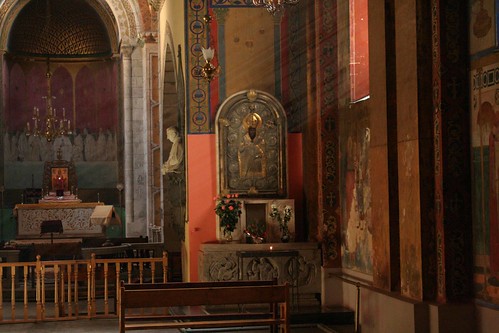
The gloom of the Armenian chapel was pierced by this shaft of sunlight.
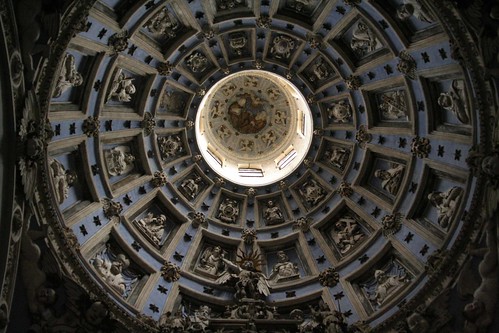
This is the dome of the Boyim Chapel, the tomb belonging to a Hungarian noble family. Each of the 36 sconces holds a Catholic saint. This chapel is most noted for the seated Jesus on its roof, a skull at his feet. I didn't get a photo though.
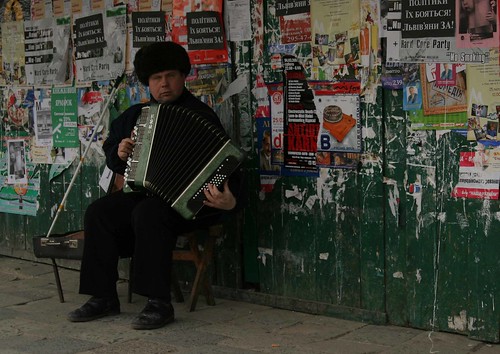
I wonder if this is the same accordianist from Uzhgorad.

The gloom of the Armenian chapel was pierced by this shaft of sunlight.

This is the dome of the Boyim Chapel, the tomb belonging to a Hungarian noble family. Each of the 36 sconces holds a Catholic saint. This chapel is most noted for the seated Jesus on its roof, a skull at his feet. I didn't get a photo though.

I wonder if this is the same accordianist from Uzhgorad.
Faces of Lviv
I think Lviv, with its baroque and neo-renaissance architecture and fine bakeries, is the nicest Ukrainian city. Of course, I have some Polish friends who cringe when those two words are used next to each other. Control of Lviv seesawed among Poles, Turks, Austro-Hungarians and Germans, and the Poles are still more than a little bitter over losing the city in 1944 to the Russians.
It's easy to get the impression in Lviv that you're being watched.
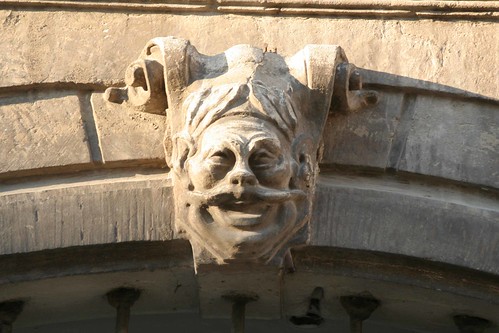
Jester
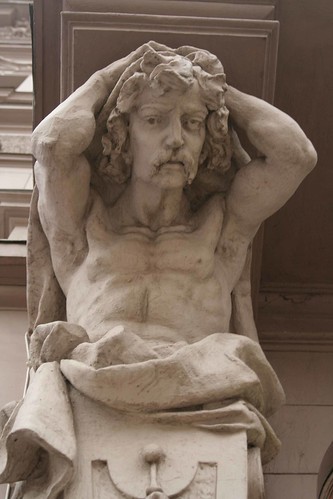
Hippy
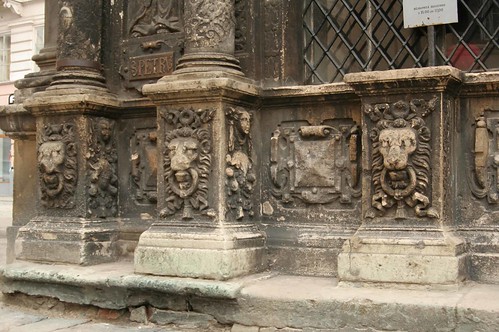
Lions on the Boyim Chapel, a tomb of a Hungarian noble family
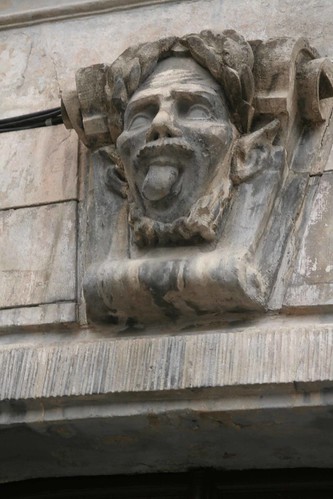
Tongue
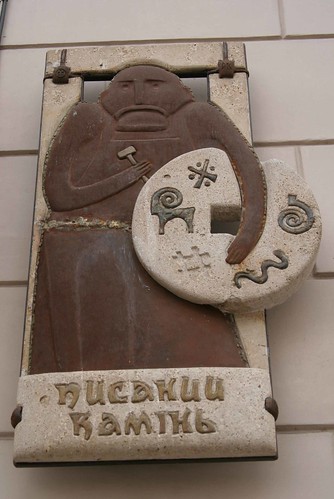
Wheel guy
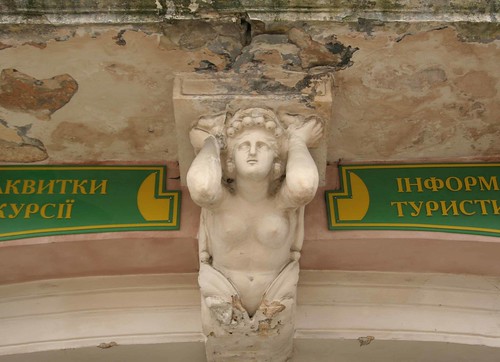
Boobs
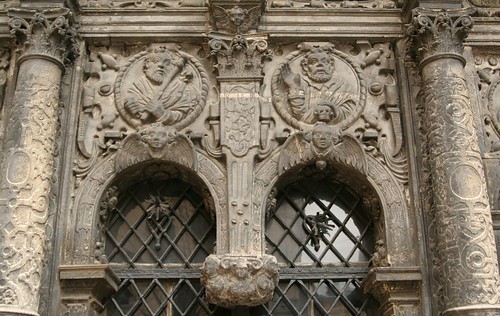
Boyim Chapel
It's easy to get the impression in Lviv that you're being watched.

Jester

Hippy

Lions on the Boyim Chapel, a tomb of a Hungarian noble family

Tongue

Wheel guy

Boobs

Boyim Chapel
Sunday, February 26, 2006
Happy Red Army Day!
Thursday was Red Army Day, a holiday that is still acknowledged in Ukraine. The Ukies in my office organized a rather elaborate lunch to celebrate, with red wine, champagne, pizza, red caviar on toast, fruit and boxed candy.
Admittedly, I found this a little hard to swallow. As I understood it, the Red Army was like the boorish uncle who showed up late to the party emptyhanded, drank all the liquor and kicked the dog. Why acknowledge it with toasts and a two-hour long lunch?
Turns out that while it’s still called Red Army Day, it has been transformed into the equivalent of the much-beloved International Women’s Day on March 8th, only for men, even if they never got anywhere near a tank or a gun.
International Women’s Day is a HUGE deal in the former Soviet Union. In fact, I remember the traffic in Baku on that day at its worst, with Ladas and Hummers alike double and triple parked in front of perfume shops and flower stores. A man gets a free pass to behave boorishly 364 days a year as long as he congratulates every woman in his life – from teachers and bosses to his mother, wives, daughters and all his mistresses -- on March 8th. In fact, in Baku, you could tell it was International Women’s Day because the restaurants were filled with nervous, dolled up housewives, strained conversations and men exchanging sympathetic glances with each other, eager to exchange wives for whores.
Personally, I find there are simply not enough opportunities to celebrate the accomplishments of men. So let’s raise a glass of Armenian cognac at lunch on Red Army Day to all the men in our lives who find the time to protect the Fatherland AND all of us weak women.
Admittedly, I found this a little hard to swallow. As I understood it, the Red Army was like the boorish uncle who showed up late to the party emptyhanded, drank all the liquor and kicked the dog. Why acknowledge it with toasts and a two-hour long lunch?
Turns out that while it’s still called Red Army Day, it has been transformed into the equivalent of the much-beloved International Women’s Day on March 8th, only for men, even if they never got anywhere near a tank or a gun.
International Women’s Day is a HUGE deal in the former Soviet Union. In fact, I remember the traffic in Baku on that day at its worst, with Ladas and Hummers alike double and triple parked in front of perfume shops and flower stores. A man gets a free pass to behave boorishly 364 days a year as long as he congratulates every woman in his life – from teachers and bosses to his mother, wives, daughters and all his mistresses -- on March 8th. In fact, in Baku, you could tell it was International Women’s Day because the restaurants were filled with nervous, dolled up housewives, strained conversations and men exchanging sympathetic glances with each other, eager to exchange wives for whores.
Personally, I find there are simply not enough opportunities to celebrate the accomplishments of men. So let’s raise a glass of Armenian cognac at lunch on Red Army Day to all the men in our lives who find the time to protect the Fatherland AND all of us weak women.
Tuesday, February 21, 2006
Controversy in Baku
So the Financial Times' FDI magazine recently published a fantasmagorical article proclaiming Baku as a "2006/2007 European City of the Future." The panel decreed:
It's hard to know if this was written by a European who has never been to Azerbaijan, or an Azeri who has never been to Europe. People who have been to both Europe and Baku take issue with this assessment, particularly the acid-tongued Breed:
Indeed, Baku has taken a huge step toward becoming an American city of the future. Look at all the stolen elections. And it already has two McDonald's!
I think the panel needs to seriously re-examine the model against which these cities are being judged.
EASTERN EUROPE/WESTERN CIS:
Winner: Baku, Azerbaijan
Runner up: Rivne City, Ukraine
With an estimated GDP of more than 12.6bn for 2005 and an economy growing at more than 10% a year, Baku is emerging as an important economic powerhouse for the Western Commonwealth of Independent States (CIS) countries. The Azerbaijan government estimates that more than €4bn in FDI flowed into the city in 2005.
IT and communications are still catching up with EU standards, but more than one in four people have access to the internet, and data connection speeds of up to 500 megabits a second are available. Modern housing is available close to shopping areas where familiar outlets such as Polo, Benetton and McDonald’s have opened.
It's hard to know if this was written by a European who has never been to Azerbaijan, or an Azeri who has never been to Europe. People who have been to both Europe and Baku take issue with this assessment, particularly the acid-tongued Breed:
"With an economy based on oil and corruption, it's difficult to see how the FT figured this one. While the Azeris rich enough to have bought their government positions can estimate whatever they like, if more than €4bn foreign direct investment flowed into the city in 2005, one wonders how much ended up outside the personal control of the folks estimating FDI (perhaps that's how they know - just checking their savings passbooks). Lots of pretty buildings (if your sense of aesthetics is in your ass), but driving between any point A and any point B will reveal the decrepit state of the infrastructure.
"'IT and communications are still catching up with EU standards' is one of the grimmest pieces of understatement I have ever heard. Ever. The only reason the average Ramiz has access to the internet is (a) internet cafes and (b) the prodigious labor of international NGOs, e.g. through IATP et al.
"Does anyone reading this in Baku have data connection speeds of up to 500 megabits a second?
"In my country - which is, admittedly, not Europe - we have gas and power 24/7. This is what we call "modern housing." Is there another standard of which I am unaware?
"However, I note that neither respect for human rights, the rule of law, nor issues of transparency are mentioned, but that good shopping is a desirable quality. Perhaps Baku is becoming the American city of the future? One can only hope."
Indeed, Baku has taken a huge step toward becoming an American city of the future. Look at all the stolen elections. And it already has two McDonald's!
I think the panel needs to seriously re-examine the model against which these cities are being judged.
Sunday, February 19, 2006
Democratic Night Life
I stepped outside last night to the sound of motion. Water in motion. Flowing, dripping, splashing and slopping water. This can mean only one thing:
A thaw.
The temperature rose above freezing for the first time since I arrived in Ukraine, so the sound of moving water was a new addition to the landscape. I’m not so naïve to believe, as much as I want to, that the water won’t revert to its silent solid form again soon. But 35 degrees is a heat wave to be immediately enjoyed.
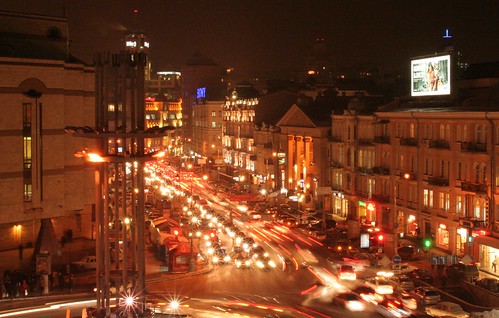
Night Life at Ploschad Tolstoho, from the balcony of my apartment
On Saturdays and Sundays, Khryshchatik, the main thoroughfare through downtown Kyiv, is shut to cars. Last night, thousands of families, pensioners and young people emerged from their holes in the ground to stroll, hat- and glove-free, through the puddles. Dogs ran free in the street, jumping over softening snow drifts, pursing their own agendas.
Coming from Baku, which has an anemic youth and creative culture, Khryshchatik on a Saturday night was almost thrilling. Street performers, ranging from two guys playing blues guitar at a bus shelter to three- and four-piece bands with horns, staked out territory at polite intervals, invisible behind their audiences. Next week, I have to remember to bring small bills with me since I saw at least three performers worthy of financial support as I walked to Planeta Sushi for dinner.
Kyiv has lots of bars and clubs, but most are priced out of the range of its residents, especially young people. Plus there’s the issue of their appeal – the people who most want to hang out in swanky oligarch bars tend to be other oligarchs and whores.
For those who would prefer to mix with the masses, Kyiv has an underworld of passages beneath the streets that serve as pedestrian underpasses and mini-malls. They’re labyrinthine, damp, dark and surprisingly, completely safe. Out of the wind, they’re surprisingly warm and hardly smell at all. At night, they provide the infrastructure for the most democratic of bar cultures.
Because there is also no legal or social stigma attached to drinking in public, entrepreneurs – mostly older women – set up tables offering as many different bottled beers as you can buy in a bar at proletarian prices, no refrigeration needed. They also offer cigarettes and the favored beer snacks of chips and dried fish. There are just as many flower vendors, whose wares slyly encourage impulsive hook-ups in dark corners and side alleys.
Why pay a $20 cover at the nightclubs?
What the passages lack in atmosphere, they make up for in energy. Last night, the passage under the famous Maydan was the scene of a battle of the bands. Hundreds of young people surrounded a band doing Nirvana covers. Around the corner, another band attracted a huge crowd with its less identifiable – possibly original – work. Around another corner, a very small handful of appreciative passersby admired a solo violinist. Others stood in small circles out of music range, bottles in hand, chatting and smoking cigarettes.
I can’t wait until summer!
A thaw.
The temperature rose above freezing for the first time since I arrived in Ukraine, so the sound of moving water was a new addition to the landscape. I’m not so naïve to believe, as much as I want to, that the water won’t revert to its silent solid form again soon. But 35 degrees is a heat wave to be immediately enjoyed.

Night Life at Ploschad Tolstoho, from the balcony of my apartment
On Saturdays and Sundays, Khryshchatik, the main thoroughfare through downtown Kyiv, is shut to cars. Last night, thousands of families, pensioners and young people emerged from their holes in the ground to stroll, hat- and glove-free, through the puddles. Dogs ran free in the street, jumping over softening snow drifts, pursing their own agendas.
Coming from Baku, which has an anemic youth and creative culture, Khryshchatik on a Saturday night was almost thrilling. Street performers, ranging from two guys playing blues guitar at a bus shelter to three- and four-piece bands with horns, staked out territory at polite intervals, invisible behind their audiences. Next week, I have to remember to bring small bills with me since I saw at least three performers worthy of financial support as I walked to Planeta Sushi for dinner.
Kyiv has lots of bars and clubs, but most are priced out of the range of its residents, especially young people. Plus there’s the issue of their appeal – the people who most want to hang out in swanky oligarch bars tend to be other oligarchs and whores.
For those who would prefer to mix with the masses, Kyiv has an underworld of passages beneath the streets that serve as pedestrian underpasses and mini-malls. They’re labyrinthine, damp, dark and surprisingly, completely safe. Out of the wind, they’re surprisingly warm and hardly smell at all. At night, they provide the infrastructure for the most democratic of bar cultures.
Because there is also no legal or social stigma attached to drinking in public, entrepreneurs – mostly older women – set up tables offering as many different bottled beers as you can buy in a bar at proletarian prices, no refrigeration needed. They also offer cigarettes and the favored beer snacks of chips and dried fish. There are just as many flower vendors, whose wares slyly encourage impulsive hook-ups in dark corners and side alleys.
Why pay a $20 cover at the nightclubs?
What the passages lack in atmosphere, they make up for in energy. Last night, the passage under the famous Maydan was the scene of a battle of the bands. Hundreds of young people surrounded a band doing Nirvana covers. Around the corner, another band attracted a huge crowd with its less identifiable – possibly original – work. Around another corner, a very small handful of appreciative passersby admired a solo violinist. Others stood in small circles out of music range, bottles in hand, chatting and smoking cigarettes.
I can’t wait until summer!
Saturday, February 18, 2006
Link Roundup
As part of the painful transition from blogging in one Crapistan to another, I've updated my woefully out-of-date links list, adding a couple of interesting blogs here in Ukraine. Most of them cover politics, which is really nice to read since in Baku there was little -- nay, nothing -- in English worth reading about the political environment.
Worry not, Carpetblogger will not be commenting on gas deals, lighthouses or the Black Sea Fleet. Carpetblogger will continue hardhitting coverage of lifestyles of the debased and delirious, if only she can find out where these folks hang out.
Here are a couple I've come across lately. Chase Me Ladies, I'm in the Cavalry for some witty writing about the world, Foreign Notes and Orange Ukraine for Ukrainian political coverage. Neeka's backlog is nice too. Why most of these blogs don't have RSS is beyond me.
Worry not, Carpetblogger will not be commenting on gas deals, lighthouses or the Black Sea Fleet. Carpetblogger will continue hardhitting coverage of lifestyles of the debased and delirious, if only she can find out where these folks hang out.
Here are a couple I've come across lately. Chase Me Ladies, I'm in the Cavalry for some witty writing about the world, Foreign Notes and Orange Ukraine for Ukrainian political coverage. Neeka's backlog is nice too. Why most of these blogs don't have RSS is beyond me.
As Azerbaijan "Marches Toward Europe"
Europe needs to be fully apprised of what it's getting.
That clever minx Sasha had the brilliant idea to compile "Azerisms" heard and marveled at throughout the ages. She put out a call, offering valuable prizes to he or she who submitted the best and/or most Azerisms. Response was overwhelming and she was kind enough to allow Carpetblogger to publish them. Some are uniquely Azeri, others are common to the Soviet Union.
Prizes:
First place: REAL Skippy peanut butter. Extra crunchy.
Second place: A bottle of Yeddi Gozelli or Qiz Qalasy
Third place: A bottle of Naxchivani chacha.
Abridged and categorized for your reading pleasure, the vast majority of responses came in the categories of "diet" and "health care." Here goes:
Foods Inadvisable to Mix:
*If you drink water while eating watermelon you will instantly develop extreme diarrhea and/or die
*Eating melon and honey is poisonous when consumed simultaneously and could be likened to mixing chlorine and ammonia, but in an edible way.
*Walnuts and water will kill you
Diet Advice
*Never eat water melons before August as they've been injected with contaminated water to 'bulk them up'.
*Eggplant is good for the liver; particularly in the winter.
*One spoonful of tomato paste first thing in the morning and one before bed is the key to long life.
*The best kebab has the most ass-fat
*Drinking water gives you a headache.
*Tea is best consumed by placing a sugar cube (or piece of candy) in your teeth and slurping tea through it. Corollary: Gold teeth are sexy.
Health Care
*Put a vodka compress on your ache
*Don't sit on the concrete or you'll freeze your ovaries. Wrap your hips in a shawl to keep them warm at all times.
*Roll a hot egg across your throat when it is sore
*Walking in cold water will give you kidney infections
*Solar flares cause high blood pressure
*Diabetes is cured by centrifuging the blood.
*To cure a cold, put your head under a pot of steaming potatoes to clear out your sinuses, then smash the potatoes on your chest and go to bed.
*To cure a tight jaw/TMG, stop reading heavy books before bedtime that make your brain think too hard.
*Rolling in the Mardakan sand (preferably while wrestling with another man in his tighty whiteys) is good for your skin.
*The surest preventative for catching a cold or flu is to put a tablespoon of kerosene in a glass of water and drink it.
*Put a cactus next to your computer monitor to absorb the radiation.
Sex
*Walnuts and honey make you horny
*The reason Azeri men have to take their brothers/cousins/friends to the whore house before their wedding night is because otherwise they could "hurt" their wife on their wedding night.
*Taking it in the backdoor preserves virginity
*The sheep like it.
Flora and Fauna
*Dogs can understand only Russian. That is why only Russian speaking families (not Azeri ones) keep pet dogs.
Education
*When you scold a boy, his testicles shrivel to half their normal size.
*If a child misbehaves in class, it's the teacher's fault for not being entertaining enough.
*A teacher should give the boys only the easy questions because they need a self-esteem boost.
Politics and Civil Society
*Its not littering if you throw only one thing out the window.
*Presidents of other countries frequently called now-dead dictator, former KGB head Heydar Aliyev for advice on leadership
*Sex always surrounds women in Azeri politics; that’s why programs supporting women in politics should be opposed.
* Bread product must never be thrown away, nor be left upside down, lest bread overlord be offended.
Highway Safety
*Wearing a seatbelt is tantamount to admitting that you cannot drive properly and are probably gay.
*Passengers who put their seatbelts on in your car do so because they believe you are gay.
*Turning on your headlights will irreparably damage the car battery and is a sign you're gay.
*To conserve fuel, kill the engine and coast down any incline.
*In order to minimize your loss in case your car is stolen NEVER put more than one liter of fuel in the tank at any time.
*The concept of Preventative Maintenance is a Western myth intended to screw more money out of you.
*NEVER drive through a puddle. It is safer to drive into the incoming traffic than risk getting your tires wet.
*Only whores sit in front. Men who sit in back are gay.
Misplaced National Pride/Wishful thinking
*Azeris make the best plov
*Television was invented by an Azeri living in Azerbaijan in the 1920s
*There are no homosexuals in Azerbaijan
*Azerbaijan, or any city within it, is European
That clever minx Sasha had the brilliant idea to compile "Azerisms" heard and marveled at throughout the ages. She put out a call, offering valuable prizes to he or she who submitted the best and/or most Azerisms. Response was overwhelming and she was kind enough to allow Carpetblogger to publish them. Some are uniquely Azeri, others are common to the Soviet Union.
Prizes:
First place: REAL Skippy peanut butter. Extra crunchy.
Second place: A bottle of Yeddi Gozelli or Qiz Qalasy
Third place: A bottle of Naxchivani chacha.
Abridged and categorized for your reading pleasure, the vast majority of responses came in the categories of "diet" and "health care." Here goes:
Foods Inadvisable to Mix:
*If you drink water while eating watermelon you will instantly develop extreme diarrhea and/or die
*Eating melon and honey is poisonous when consumed simultaneously and could be likened to mixing chlorine and ammonia, but in an edible way.
*Walnuts and water will kill you
Diet Advice
*Never eat water melons before August as they've been injected with contaminated water to 'bulk them up'.
*Eggplant is good for the liver; particularly in the winter.
*One spoonful of tomato paste first thing in the morning and one before bed is the key to long life.
*The best kebab has the most ass-fat
*Drinking water gives you a headache.
*Tea is best consumed by placing a sugar cube (or piece of candy) in your teeth and slurping tea through it. Corollary: Gold teeth are sexy.
Health Care
*Put a vodka compress on your ache
*Don't sit on the concrete or you'll freeze your ovaries. Wrap your hips in a shawl to keep them warm at all times.
*Roll a hot egg across your throat when it is sore
*Walking in cold water will give you kidney infections
*Solar flares cause high blood pressure
*Diabetes is cured by centrifuging the blood.
*To cure a cold, put your head under a pot of steaming potatoes to clear out your sinuses, then smash the potatoes on your chest and go to bed.
*To cure a tight jaw/TMG, stop reading heavy books before bedtime that make your brain think too hard.
*Rolling in the Mardakan sand (preferably while wrestling with another man in his tighty whiteys) is good for your skin.
*The surest preventative for catching a cold or flu is to put a tablespoon of kerosene in a glass of water and drink it.
*Put a cactus next to your computer monitor to absorb the radiation.
Sex
*Walnuts and honey make you horny
*The reason Azeri men have to take their brothers/cousins/friends to the whore house before their wedding night is because otherwise they could "hurt" their wife on their wedding night.
*Taking it in the backdoor preserves virginity
*The sheep like it.
Flora and Fauna
*Dogs can understand only Russian. That is why only Russian speaking families (not Azeri ones) keep pet dogs.
Education
*When you scold a boy, his testicles shrivel to half their normal size.
*If a child misbehaves in class, it's the teacher's fault for not being entertaining enough.
*A teacher should give the boys only the easy questions because they need a self-esteem boost.
Politics and Civil Society
*Its not littering if you throw only one thing out the window.
*Presidents of other countries frequently called now-dead dictator, former KGB head Heydar Aliyev for advice on leadership
*Sex always surrounds women in Azeri politics; that’s why programs supporting women in politics should be opposed.
* Bread product must never be thrown away, nor be left upside down, lest bread overlord be offended.
Highway Safety
*Wearing a seatbelt is tantamount to admitting that you cannot drive properly and are probably gay.
*Passengers who put their seatbelts on in your car do so because they believe you are gay.
*Turning on your headlights will irreparably damage the car battery and is a sign you're gay.
*To conserve fuel, kill the engine and coast down any incline.
*In order to minimize your loss in case your car is stolen NEVER put more than one liter of fuel in the tank at any time.
*The concept of Preventative Maintenance is a Western myth intended to screw more money out of you.
*NEVER drive through a puddle. It is safer to drive into the incoming traffic than risk getting your tires wet.
*Only whores sit in front. Men who sit in back are gay.
Misplaced National Pride/Wishful thinking
*Azeris make the best plov
*Television was invented by an Azeri living in Azerbaijan in the 1920s
*There are no homosexuals in Azerbaijan
*Azerbaijan, or any city within it, is European
Sunday, February 12, 2006
Even Though I am Currently in Ukraine,
You would hardly know it based on my posts. In the two weeks I've been here, I've been in such hotspots (and boy, do I ever use the word "hot" loosely) as Kherson (east of Odessa), Poltava (between Kyiv and Kharkiv, in central Ukraine) and Uzhgorad (on the border with Slovakia and Hungary). Lviv, Vinnytsya, Zaporizhzhia and Dnipropetrovsk are on the agenda for the coming weeks.
I put these photos in the "mildly interesting" category.
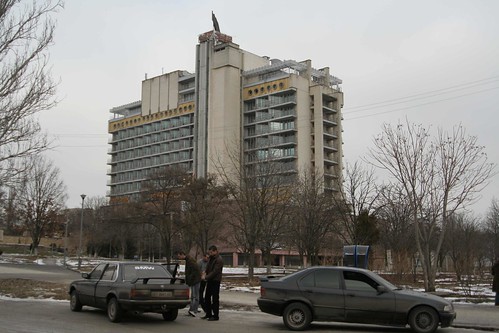
Frigat Hotel in Kherson
Let's pause for a moment to extol the virtues of Intourist hotels. Moment passed. This is the Frigat hotel in Kherson. To its credit, it was the only operation in Kherson that weekend that had running water. To its detriment, it had very little heat. Kherson, which sits at the mouth of the Dnipro where it empties into the Black Sea, was a shipbuilding center from the time of Catherine the Great. If you look carefully, the Frigat displays architectural details reminiscent of a ship. Hardly redeeming. Inside, it had been remodeled, but by people who saw nothing wrong with the original. If you have never been inside an Intourist hotel, they are generally as charming as a mental institution, with low ceilings, a lobby filled with whores, a casino, exposed water pipes and magenta-haired dzurnas, or floor ladies, who monitor comings and goings on each floor. They also have a distinctive smell of mildew, cold cement and cat pee.
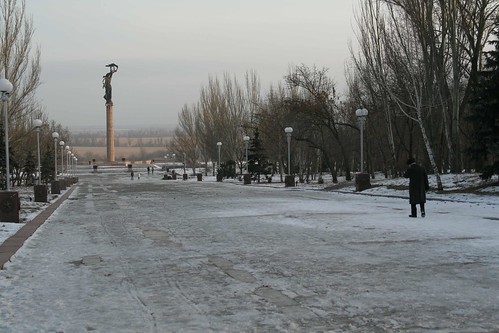
Kherson War memorial
As critical as we may be about their hotel design, the Soviets really excelled at large public spaces and war memorials. This long promenade slopes down toward the Dnipro, where it ends with a war memorial/homage to the shipworkers combo. Very creative. Very icy, too.
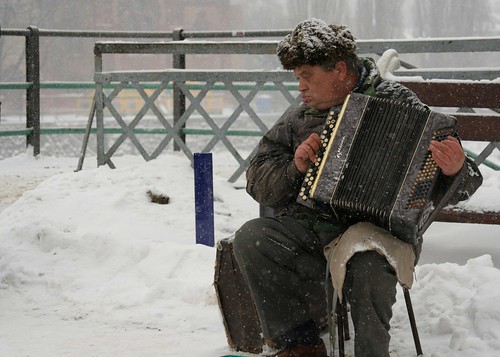
Uzhgorad Musician
Uzhgorad has a high degree of civilization, owing to the fact that it's right next to Hungary and Slovakia and lots of its residents work in Europe. Uzhgorad sounds weird but it just means city on the Uzh River, which runs through the center of town when it is not frozen solid. The Uzh river is the habitat of a non-poisonous snake that eats frogs and swims in a "z" pattern. There is an outstanding small hotel there (by western standards, even) and a bar that has live blues and serves excellent spicy Hungarian fish soup. It would have been even better if the snow hadn't been knee deep.
Who knew? The New York Times shared some typically trite insights and dull writing about Uzhgorad just a few weeks ago.
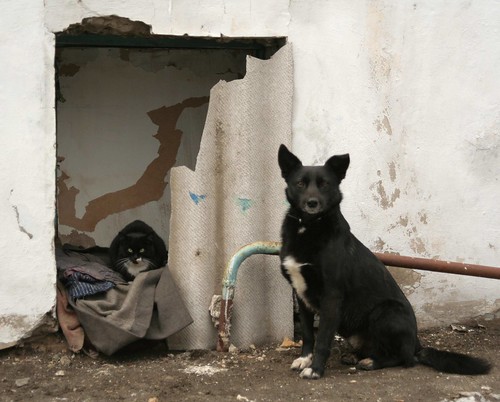
Kherson Guard
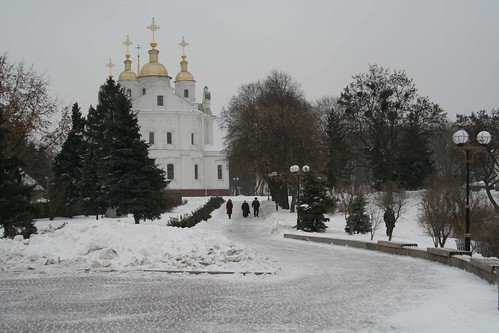
Poltava Church
Give the people what they came for. Gold onion-domed churches. And snow. Poltava is interesting because it's sort of in eastern Ukraine, which tends to be more pro-Russian. But, interestingly, Poltavans are reputed to speak the purest Ukrainian in the country, owing to the large number of writers who hail from the city.
I put these photos in the "mildly interesting" category.

Frigat Hotel in Kherson
Let's pause for a moment to extol the virtues of Intourist hotels. Moment passed. This is the Frigat hotel in Kherson. To its credit, it was the only operation in Kherson that weekend that had running water. To its detriment, it had very little heat. Kherson, which sits at the mouth of the Dnipro where it empties into the Black Sea, was a shipbuilding center from the time of Catherine the Great. If you look carefully, the Frigat displays architectural details reminiscent of a ship. Hardly redeeming. Inside, it had been remodeled, but by people who saw nothing wrong with the original. If you have never been inside an Intourist hotel, they are generally as charming as a mental institution, with low ceilings, a lobby filled with whores, a casino, exposed water pipes and magenta-haired dzurnas, or floor ladies, who monitor comings and goings on each floor. They also have a distinctive smell of mildew, cold cement and cat pee.

Kherson War memorial
As critical as we may be about their hotel design, the Soviets really excelled at large public spaces and war memorials. This long promenade slopes down toward the Dnipro, where it ends with a war memorial/homage to the shipworkers combo. Very creative. Very icy, too.

Uzhgorad Musician
Uzhgorad has a high degree of civilization, owing to the fact that it's right next to Hungary and Slovakia and lots of its residents work in Europe. Uzhgorad sounds weird but it just means city on the Uzh River, which runs through the center of town when it is not frozen solid. The Uzh river is the habitat of a non-poisonous snake that eats frogs and swims in a "z" pattern. There is an outstanding small hotel there (by western standards, even) and a bar that has live blues and serves excellent spicy Hungarian fish soup. It would have been even better if the snow hadn't been knee deep.
Who knew? The New York Times shared some typically trite insights and dull writing about Uzhgorad just a few weeks ago.

Kherson Guard

Poltava Church
Give the people what they came for. Gold onion-domed churches. And snow. Poltava is interesting because it's sort of in eastern Ukraine, which tends to be more pro-Russian. But, interestingly, Poltavans are reputed to speak the purest Ukrainian in the country, owing to the large number of writers who hail from the city.
Graffiti in Georgian is Redundant
I made my escape from Azerbaijan through Georgia, a country in which I regret not having spent more time, especially in the summer. I enjoyed several exceptional meals in the cellar bar at World of Urine in Tbilisi. Now of course that's not really its name -- it's called World of Wine, and it's just around the corner from the opera house. The sign outside is written in such a way that calls into question what's really on offer inside. It's a great place to learn a little about Georgian winemaking from the helpful owner, who unfortunately doesn't speak English. Alternatively, you can sit in the woody bar and drink $1 glasses of Tsinidali while people who speak Russian broaden their minds.
A friend who lived in Tbilisi for several years commented that when the UFOs land on earth, their space ships will have Georgian written on the outside. Georgian script, to me, is completely inscrutable.
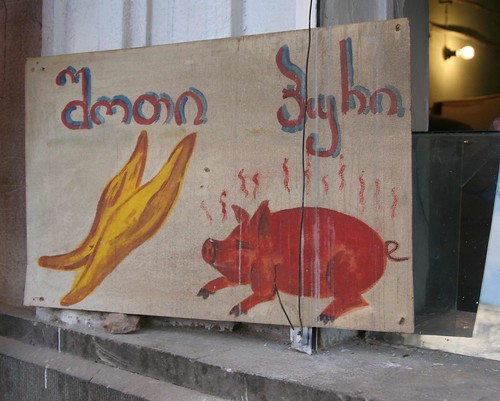
Pork products and something else -- could it be plantains? -- on sale herein
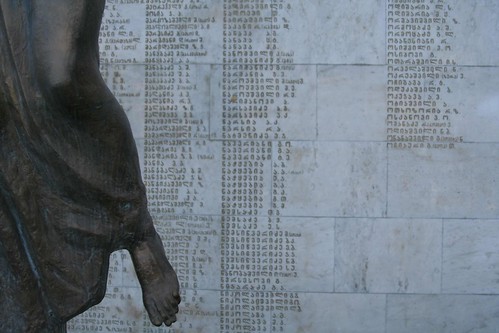
War Dead
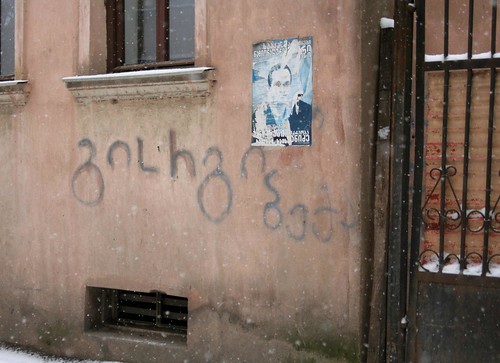
Redundant graffiti
A friend who lived in Tbilisi for several years commented that when the UFOs land on earth, their space ships will have Georgian written on the outside. Georgian script, to me, is completely inscrutable.

Pork products and something else -- could it be plantains? -- on sale herein

War Dead

Redundant graffiti
Saturday, February 11, 2006
If you can't get enough of Azeri standards of beauty
Then you're going to love this photo of Miss Azerbaijan 2006, submitted by longtime reader and first-time puppy abandoner, Baku Stevie. I can't credit BS with the photo -- he reports he didn't want to pay $200 for a seat at the event. Where are his values? -- but kudos to whoever did.
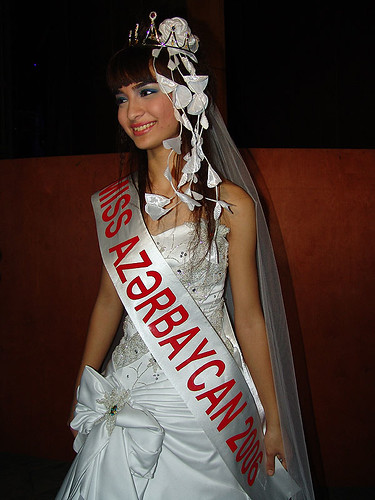

There's Bird Flu in Azerbaijan!
But the government said all those dead birds with black heads died from malnutrition. The vet laboratory in Barda confirmed it! I hardly know who to believe any more. If you can't trust the government of Azerbaijan, and the lab in Barda, who can you trust?
Bad news for those of you in Baku who like to kiss bird heads and fondle raw poultry. You know who you are.
Bad news for those of you in Baku who like to kiss bird heads and fondle raw poultry. You know who you are.
Monday, February 06, 2006
On the Baku Catwalk
Since I can't think of anything new and interesting to write about, I'm posting things I wrote a while back. The Best Model contest happened in November.
On The Catwalk, Azerbaijan-Style
Dappled thighs reverberate down the runway, their young owners blissfully unaware of the stigma attached to fashion models with cellulite in other parts of the world. These young women clearly had spent more time watching Baku’s basic cable staple “Fashion TV” than hitting the gym.
With an economy fueled by oil riches from the Caspian Sea, a dictator who keeps a tight rein on things and thuggish neighbors to the North, South and West, Azerbaijan is becoming known as the oasis between Iran and Chechnya. Baku, its booming capital city, perches on the southern lip of the Absheron peninsula like a gray canker.
Modeling, and the fashion industry that depends on it, are nascent in Azerbaijan. But as the riches pour in, demand for extravagant designer fashion among those with more money than taste is surging. Baku recently hosted The Best Model of Azerbaijan 2005 competition, which pitted 30 model wannabes between the ages of 15 and 25 against each other for the chance to move on the clumsily-named The Best Model of the World competition in Istanbul, Turkey.
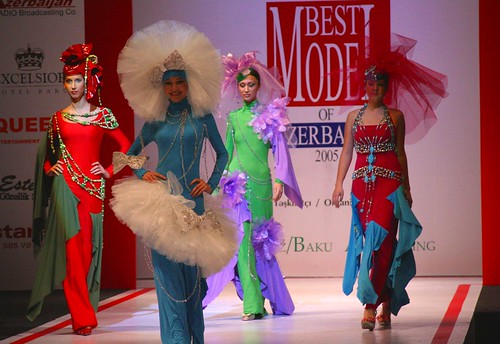
The Mosaika Collection
The Istanbul final attracts the Best Model winners from around the world. The roster of past title holders reflects an appreciation for the world’s diverse standards of beauty. Turks, Ukrainians, Senegalese, Kazakhs, Togolese and Brits have all come away with top awards in the contest. Azeribaijani model Sevda Aliyeva (no relation to Azerbaijan’s current President) won the contest in 2000. Azerbaijani and Armenian models even put aside their nations’ differences to compete peacefully against each other for the title.
The Best Model of Azerbaijan 2005 is part fashion show, part beauty contest, though its promoters are loathe to put it in the declasse latter category. There was no talent competition, but there was a gawky group dance number and a bathing suit competition.
The 2000-seat Heydar Aliyev Palace, known more prosaically as Republic Palace in the days before the dead dictator was elevated to icon status, served as the venue. The boxy communist-era hall sits in the middle of the capital city. Its front doors open onto the Heydar Aliyev park, an unwelcoming block of shiny marble fountains and park benches refurbished last year, at significant expense, in honor of Aliyev’s birthday. Like many public spaces in Azerbaijan, the park is dominated by an enormous bronze statue of Aliyev.
Aliyev’s bronze back is toward the culture palace, while he reaches out grandly toward the glistening orange National Bank at the other end of the square. This, local wags point out, accurately encapsulates the current state of affairs in Azerbaijan under Aliyev’s son and handpicked successor, Ilham.
Back to culture, grabbing for money.
Conventional wisdom would suggest that most audience members at The Top Model of Azerbaijan fall into the “horny young man” demographic, but surprisingly, women and children seemed to fill most of the seats. Wives and mistresses of Baku’s oil kleptocracy donned their best designer rip-offs for the evening. Clearly, plastic surgery is a priority for these arrivistes, but the demand seems to have outstripped the supply of qualified surgeons. Pyramid-shaped breasts popped out of too-tight blouses and lopsided lips were accentuated by garish glosses.
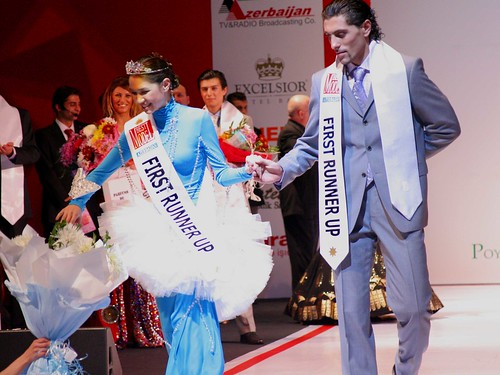
Runners up. My money was on them to win. They wuz robbed!
All former Soviet states seem to have gone through an awkward phase, fashion-wise, after shedding their communist skin. Some of them outgrow it faster than others. Fourteen years after independence, Azerbaijani women still have a hard time distinguishing between day and evening wear and men prefer their suits shiny and dress shoes pointy-toed like scimitars. Modeling was discouraged during Soviet times and not just because there wasn’t much worth modeling.
The Azerbaijanis are still trying to work the kinks out.
The winner of “Best Grace,” teetered along on her stiletto heels, nearly falling with every step. A male contestant sported a grisly, ravine-like scar on the back of his thigh, the story behind which would surely provide compelling subject matter for a gauzy “obstacles overcome” video bumper. Frumpy underwear belonging to a spunky 15-year old contestant peeked over the top of her evening gown.
In perhaps a nod to the Islamic nation’s Shi’ite population, the opening swimsuit competition was demure by western standards. Men and women alike wore the same unflattering Speedos that Olympic swimmers wear. The women’s maillots did little to enhance their gifts.
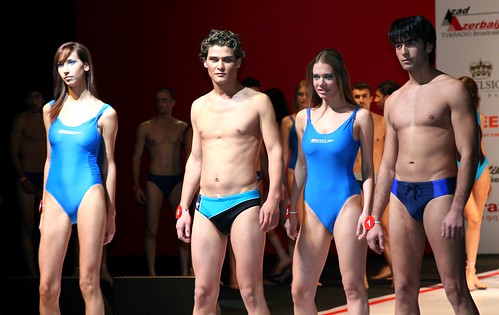
No banana hammocks for the men, either.
Not only were Azeri ideals of beauty on display, the contest also showcased local haute couture. Local designers ornamented their evening and club wear creations with pleather, synthetic fur, mirrors, fake feathers, metallic scales, handcuffs and even the ubiquitous blue and yellow Turkish evil eye. I’m no expert on fashion history, but The Best Model of Azerbaijan 2005 might be the first time in which a collection inspired by Attila the Hun appeared on a runway. One model with cro-magnum features and bow legs creaked down the runaway to a soundtrack of howling wolves, wearing a horned fur hat and a fake leather tunic.
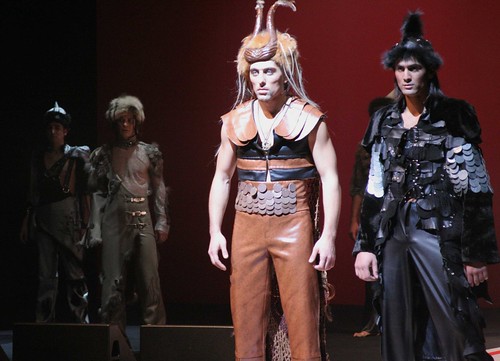
Atilla Collection
The overall effect was not pleasing – in fact, sometimes even deeply troubling -- to westerners like myself. The local audience, however, greeted the collections with enthusiasm.
The runway shows were interspersed by interminable performances by some of Azerbaijan’s biggest pop stars, many of whom are little more than karaoke singers. Samir, a flamboyantly dressed popular singer widely believed to be gay, served as a reminder that the world fashion industry the world has thrived under the creative stewardship of gay men. Perhaps Azerbaijani designers could benefit by getting touch with their inner fag.
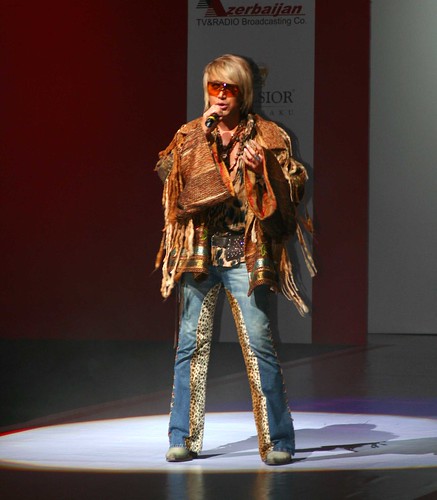
Faig
This being Azerbaijan, which has never held a free election and been rated one of world’s most corrupt countries for years, the contest couldn’t have come off without a whiff of scandal. At the end, an unintroduced model, wearing a gold trimmed Cleopatra-style gown, wig and heavy makeup, swept confidently onto the stage. The deeply disguised competition organizer launched into a high-pitched, intoxicant-fueled tirade in which she answered unasked questions about her own, and the organizing committee’s, professionalism. Just as the audience started to egg her on, organizers cut the power to her microphone. This spontaneous display of unscripted verbal terrorism was the highlight of the evening, even if it was in Russian.
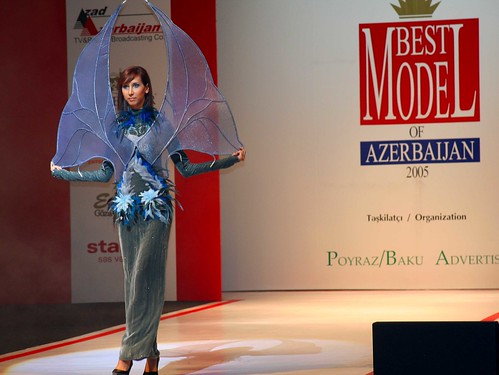
This was the winner. Really. She won!
The Best Model of Azerbaijan contest showed that western images of beauty, fashion and floor shows have yet to penetrate a culture shaped by its communist past and oil-soaked future. The Azerbaijanis, however, are embracing their homegrown fashion industry and models with enthusiasm.
Cellulite and all.
On The Catwalk, Azerbaijan-Style
Dappled thighs reverberate down the runway, their young owners blissfully unaware of the stigma attached to fashion models with cellulite in other parts of the world. These young women clearly had spent more time watching Baku’s basic cable staple “Fashion TV” than hitting the gym.
With an economy fueled by oil riches from the Caspian Sea, a dictator who keeps a tight rein on things and thuggish neighbors to the North, South and West, Azerbaijan is becoming known as the oasis between Iran and Chechnya. Baku, its booming capital city, perches on the southern lip of the Absheron peninsula like a gray canker.
Modeling, and the fashion industry that depends on it, are nascent in Azerbaijan. But as the riches pour in, demand for extravagant designer fashion among those with more money than taste is surging. Baku recently hosted The Best Model of Azerbaijan 2005 competition, which pitted 30 model wannabes between the ages of 15 and 25 against each other for the chance to move on the clumsily-named The Best Model of the World competition in Istanbul, Turkey.

The Mosaika Collection
The Istanbul final attracts the Best Model winners from around the world. The roster of past title holders reflects an appreciation for the world’s diverse standards of beauty. Turks, Ukrainians, Senegalese, Kazakhs, Togolese and Brits have all come away with top awards in the contest. Azeribaijani model Sevda Aliyeva (no relation to Azerbaijan’s current President) won the contest in 2000. Azerbaijani and Armenian models even put aside their nations’ differences to compete peacefully against each other for the title.
The Best Model of Azerbaijan 2005 is part fashion show, part beauty contest, though its promoters are loathe to put it in the declasse latter category. There was no talent competition, but there was a gawky group dance number and a bathing suit competition.
The 2000-seat Heydar Aliyev Palace, known more prosaically as Republic Palace in the days before the dead dictator was elevated to icon status, served as the venue. The boxy communist-era hall sits in the middle of the capital city. Its front doors open onto the Heydar Aliyev park, an unwelcoming block of shiny marble fountains and park benches refurbished last year, at significant expense, in honor of Aliyev’s birthday. Like many public spaces in Azerbaijan, the park is dominated by an enormous bronze statue of Aliyev.
Aliyev’s bronze back is toward the culture palace, while he reaches out grandly toward the glistening orange National Bank at the other end of the square. This, local wags point out, accurately encapsulates the current state of affairs in Azerbaijan under Aliyev’s son and handpicked successor, Ilham.
Back to culture, grabbing for money.
Conventional wisdom would suggest that most audience members at The Top Model of Azerbaijan fall into the “horny young man” demographic, but surprisingly, women and children seemed to fill most of the seats. Wives and mistresses of Baku’s oil kleptocracy donned their best designer rip-offs for the evening. Clearly, plastic surgery is a priority for these arrivistes, but the demand seems to have outstripped the supply of qualified surgeons. Pyramid-shaped breasts popped out of too-tight blouses and lopsided lips were accentuated by garish glosses.

Runners up. My money was on them to win. They wuz robbed!
All former Soviet states seem to have gone through an awkward phase, fashion-wise, after shedding their communist skin. Some of them outgrow it faster than others. Fourteen years after independence, Azerbaijani women still have a hard time distinguishing between day and evening wear and men prefer their suits shiny and dress shoes pointy-toed like scimitars. Modeling was discouraged during Soviet times and not just because there wasn’t much worth modeling.
The Azerbaijanis are still trying to work the kinks out.
The winner of “Best Grace,” teetered along on her stiletto heels, nearly falling with every step. A male contestant sported a grisly, ravine-like scar on the back of his thigh, the story behind which would surely provide compelling subject matter for a gauzy “obstacles overcome” video bumper. Frumpy underwear belonging to a spunky 15-year old contestant peeked over the top of her evening gown.
In perhaps a nod to the Islamic nation’s Shi’ite population, the opening swimsuit competition was demure by western standards. Men and women alike wore the same unflattering Speedos that Olympic swimmers wear. The women’s maillots did little to enhance their gifts.

No banana hammocks for the men, either.
Not only were Azeri ideals of beauty on display, the contest also showcased local haute couture. Local designers ornamented their evening and club wear creations with pleather, synthetic fur, mirrors, fake feathers, metallic scales, handcuffs and even the ubiquitous blue and yellow Turkish evil eye. I’m no expert on fashion history, but The Best Model of Azerbaijan 2005 might be the first time in which a collection inspired by Attila the Hun appeared on a runway. One model with cro-magnum features and bow legs creaked down the runaway to a soundtrack of howling wolves, wearing a horned fur hat and a fake leather tunic.

Atilla Collection
The overall effect was not pleasing – in fact, sometimes even deeply troubling -- to westerners like myself. The local audience, however, greeted the collections with enthusiasm.
The runway shows were interspersed by interminable performances by some of Azerbaijan’s biggest pop stars, many of whom are little more than karaoke singers. Samir, a flamboyantly dressed popular singer widely believed to be gay, served as a reminder that the world fashion industry the world has thrived under the creative stewardship of gay men. Perhaps Azerbaijani designers could benefit by getting touch with their inner fag.

Faig
This being Azerbaijan, which has never held a free election and been rated one of world’s most corrupt countries for years, the contest couldn’t have come off without a whiff of scandal. At the end, an unintroduced model, wearing a gold trimmed Cleopatra-style gown, wig and heavy makeup, swept confidently onto the stage. The deeply disguised competition organizer launched into a high-pitched, intoxicant-fueled tirade in which she answered unasked questions about her own, and the organizing committee’s, professionalism. Just as the audience started to egg her on, organizers cut the power to her microphone. This spontaneous display of unscripted verbal terrorism was the highlight of the evening, even if it was in Russian.

This was the winner. Really. She won!
The Best Model of Azerbaijan contest showed that western images of beauty, fashion and floor shows have yet to penetrate a culture shaped by its communist past and oil-soaked future. The Azerbaijanis, however, are embracing their homegrown fashion industry and models with enthusiasm.
Cellulite and all.
Sunday, February 05, 2006
Go Nuclear -- Rerun
Since nothing interesting seems to happen in Ukraine -- at least now that I'm here -- I am going to move into re-runs. Gadling has been posting about Chernobyl tours, which inspired me. When the Producer and I traveled around the world in 2003, we stopped in Kyiv for a few weeks to visit a friend. During our visit, we toured Chernobyl. This is what I wrote about it.
Go Nuclear
The former Soviet Union is rife with environmental catastrophes that have been hidden from prying eyes from decades. There are so many, in fact, that it may be time for the creation of another tourism category called, "Soviet Environmental Disasters--Greatest Hits."
Chernobyl is located just 70 miles north of Kiev and several local travel agencies offer tours. After spending a day wandering around the site of the world's worst industrial accident, I'm not sure I know any more about the mechanics of the catastrophe than I did before. I did, however, gain insight into the myths that have grown up around it. These reveal far more about the human side of the disaster than the facts anyway.
During Soviet times, the ground was always plowed and ready for rumor planting. The Chernobyl seeds were sown early in the morning on April 26th, 1986. In the intervening 17 years, myths about the disaster have taken root deep in the toxic soil. These "truths" seem to serve a number of purposes. In the days and months following the accident, they filled the information vacuum. Now, they promote the idea of Ukrainian impotence in the face of overwhelming Soviet power and fuel the fires of animosity between Ukrainians and Russians.
They also provide cover. In some cases, the truth is too awful to articulate.
We visited on a shiny fall day. Peasants were finishing up their harvest and old women in headscarves sold baskets of fresh mushrooms and apples alongside the road. As we neared the reactor, no dead trees, multi-headed deer or scorched earth provided physical evidence of what had happened. In fact, the vegetation was particularly lush and animal life abundant, both free to thrive without human interference.
In the six hours or so we spent in the zones, we received less radiation than from the average X-ray, or so they say. Still, visitors are instructed not to touch anything, just to be safe.
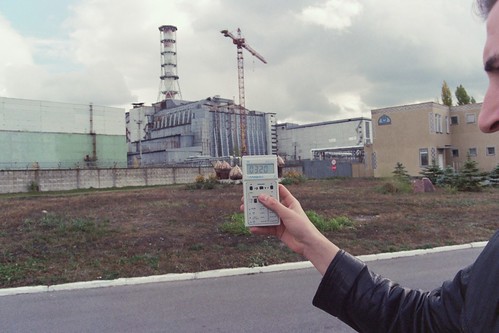
Geiger reading in front of the infamous Reactor #4
Rimma, our official guide, carried a Geiger counter, which would shut itself off at the point at which radiation levels became too high for safety. It never reached that point and it was a fun toy to have along. It was useful for conducting spot checks of radiation levels in buildings, on vegetation and on local dogs.
The first stop in the outer zone was the "Equipment Cemetery." Neat rows of hundreds and hundreds of buses, trucks, military helicopters, private cars and ambulances rust in the field where they were abandoned. These vehicles were contaminated, but not so badly that they needed to be buried like hundreds of others.
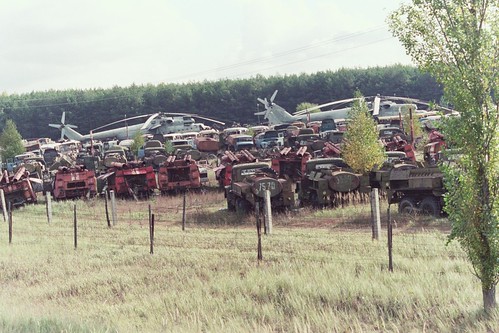
Vehicle graveyard
Chernobyl may be the name most associated with the disaster, but the city most affected by it was the town nearest the reactor, Prypiat. Prypiat lies within the Inner Zone, which includes the 10 kilometers closest to the reactor. No one lives in the Inner Zone. In fact, all villages within the Inner Zone were bulldozed and buried. The only evidence of their existence is their road signs, which hang from the ceiling of the Chernobyl Museum in Kiev.
Built specifically to house plant workers, Prypiat was a young city designed in high Soviet style -- tall grey apartment blocks, wide boulevards, a culture house, ferris wheel, hotel and restaurant. Now, it's a ghost town, left exactly as it was when its residents fled in a big hurry. It's like a little time capsule of mid-80’s life in the Soviet Union, lacking any of the billboards, cafes and consumer culture that are now part of the landscape of every other city in the former Soviet Union. Its kindergarten was strewn with pages from "Uncle Lenin" picture books. Prypiat will probably continue to decay until someone has the money to bulldoze it. Or turn it into a theme park.
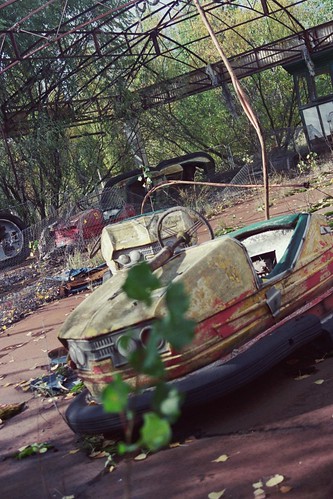
Prypiat Amusement Park
The most compelling rumors are those that made the Soviets look most craven. One of the more persistent is that families of high ranking local party officials were evacuated immediately after the fire started, at around 2:00 am on the morning of April 26. Rimma said it was impossible to know for sure if this really happened, but again, it's a plausible scenario and confirms the perception that in Soviet society, some people were more equal than others.
Evacuation of the rest of Prypiat’s 50,000 residents wasn’t complete until the evening of April 28th. Residents were allowed to take only one suitcase with them. It's now possible to explore their looted apartments, none of which have any refrigerators. Rimma said that because folks had stocked up on food in anticipation of the upcoming holiday, crews had to come in and remove the refrigerators to prevent an epidemic. She didn't know where the refrigerators are now.
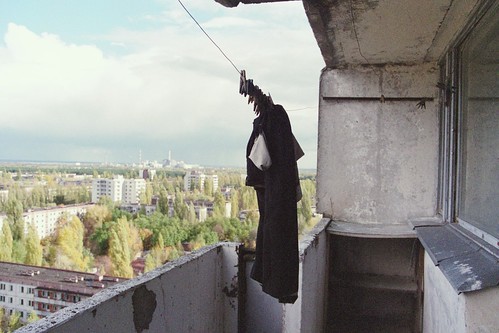
Laundry on the line in Prypiat
The cause of the accident is shrouded in mystery and thus, a prime breeding ground for rumor. The truth is entombed in the concrete sarcophagus, but for some, the date of the accident provides important clues to its cause. Reactor workers report being under pressure from high officials to demonstrate above-average power output prior to May 1, the day when the accomplishments of "the workers" and glories of the Communist party were celebrated. The reactor and its turbines were pushed beyond their capacity, resulting in the fire that destroyed the reactor and released the radiation.
The truth may never be known.
It's also impossible to know how many people died as a direct result of the accident. There's a moving memorial to the firefighters who were the first on the scene, funded and built by their comrades. Its plaque reads, “to those who saved the world.” Only one of the first responders is still alive. His longevity is attributed to the fact that he had been at a wedding the night of the accident and arrived at the fire drunk on red wine and vodka. This confirms what every Russian or Ukrainian knows --that alcohol is armor and protects against every ill, even radiation poisoning.
Rimma said the death count could be in the hundreds of thousands – possibly millions. Official counts put the number of immediate deaths at 31.
Six hundred fifty thousand “liquidators” worked at the site in the months after the disaster. What compelled this army of workers to toil at the scene, putting themselves at huge risk of radiation exposure? Rimma attributed it to Soviets' deep-seated commitment to defend the motherland."If your mother needs your help," she explained, "you do what you must." Government propaganda played into this sentiment. "The Power of the Soviet People Is Greater than the Atom" read an enormous banner hung at the reactor site.
Unfortunately, the tour was very clinical. We didn’t have the chance to talk to anyone who had been directly affected by the disaster. By placing the disaster in the category of “history,” rather than an ongoing catastrophe that will affect generations to come, the tour diminished the tragedy of Chernobyl. This, too, may prove to be another convenient coping strategy for the Ukrainians who want to put the past behind them as quickly as possible.
Near the end of the tour, our small group stood on a railway bridge, throwing bread to catfish that live in the cooling pond next to the reactor. One monster, approximately seven feet long, surfaced and snatched half a loaf before disappearing into the dark water. "That's a normal size for catfish," Rimma said quickly.
Unverifiable. But plausible? Maybe.
Go Nuclear
The former Soviet Union is rife with environmental catastrophes that have been hidden from prying eyes from decades. There are so many, in fact, that it may be time for the creation of another tourism category called, "Soviet Environmental Disasters--Greatest Hits."
Chernobyl is located just 70 miles north of Kiev and several local travel agencies offer tours. After spending a day wandering around the site of the world's worst industrial accident, I'm not sure I know any more about the mechanics of the catastrophe than I did before. I did, however, gain insight into the myths that have grown up around it. These reveal far more about the human side of the disaster than the facts anyway.
During Soviet times, the ground was always plowed and ready for rumor planting. The Chernobyl seeds were sown early in the morning on April 26th, 1986. In the intervening 17 years, myths about the disaster have taken root deep in the toxic soil. These "truths" seem to serve a number of purposes. In the days and months following the accident, they filled the information vacuum. Now, they promote the idea of Ukrainian impotence in the face of overwhelming Soviet power and fuel the fires of animosity between Ukrainians and Russians.
They also provide cover. In some cases, the truth is too awful to articulate.
We visited on a shiny fall day. Peasants were finishing up their harvest and old women in headscarves sold baskets of fresh mushrooms and apples alongside the road. As we neared the reactor, no dead trees, multi-headed deer or scorched earth provided physical evidence of what had happened. In fact, the vegetation was particularly lush and animal life abundant, both free to thrive without human interference.
In the six hours or so we spent in the zones, we received less radiation than from the average X-ray, or so they say. Still, visitors are instructed not to touch anything, just to be safe.

Geiger reading in front of the infamous Reactor #4
Rimma, our official guide, carried a Geiger counter, which would shut itself off at the point at which radiation levels became too high for safety. It never reached that point and it was a fun toy to have along. It was useful for conducting spot checks of radiation levels in buildings, on vegetation and on local dogs.
The first stop in the outer zone was the "Equipment Cemetery." Neat rows of hundreds and hundreds of buses, trucks, military helicopters, private cars and ambulances rust in the field where they were abandoned. These vehicles were contaminated, but not so badly that they needed to be buried like hundreds of others.

Vehicle graveyard
Chernobyl may be the name most associated with the disaster, but the city most affected by it was the town nearest the reactor, Prypiat. Prypiat lies within the Inner Zone, which includes the 10 kilometers closest to the reactor. No one lives in the Inner Zone. In fact, all villages within the Inner Zone were bulldozed and buried. The only evidence of their existence is their road signs, which hang from the ceiling of the Chernobyl Museum in Kiev.
Built specifically to house plant workers, Prypiat was a young city designed in high Soviet style -- tall grey apartment blocks, wide boulevards, a culture house, ferris wheel, hotel and restaurant. Now, it's a ghost town, left exactly as it was when its residents fled in a big hurry. It's like a little time capsule of mid-80’s life in the Soviet Union, lacking any of the billboards, cafes and consumer culture that are now part of the landscape of every other city in the former Soviet Union. Its kindergarten was strewn with pages from "Uncle Lenin" picture books. Prypiat will probably continue to decay until someone has the money to bulldoze it. Or turn it into a theme park.

Prypiat Amusement Park
The most compelling rumors are those that made the Soviets look most craven. One of the more persistent is that families of high ranking local party officials were evacuated immediately after the fire started, at around 2:00 am on the morning of April 26. Rimma said it was impossible to know for sure if this really happened, but again, it's a plausible scenario and confirms the perception that in Soviet society, some people were more equal than others.
Evacuation of the rest of Prypiat’s 50,000 residents wasn’t complete until the evening of April 28th. Residents were allowed to take only one suitcase with them. It's now possible to explore their looted apartments, none of which have any refrigerators. Rimma said that because folks had stocked up on food in anticipation of the upcoming holiday, crews had to come in and remove the refrigerators to prevent an epidemic. She didn't know where the refrigerators are now.

Laundry on the line in Prypiat
The cause of the accident is shrouded in mystery and thus, a prime breeding ground for rumor. The truth is entombed in the concrete sarcophagus, but for some, the date of the accident provides important clues to its cause. Reactor workers report being under pressure from high officials to demonstrate above-average power output prior to May 1, the day when the accomplishments of "the workers" and glories of the Communist party were celebrated. The reactor and its turbines were pushed beyond their capacity, resulting in the fire that destroyed the reactor and released the radiation.
The truth may never be known.
It's also impossible to know how many people died as a direct result of the accident. There's a moving memorial to the firefighters who were the first on the scene, funded and built by their comrades. Its plaque reads, “to those who saved the world.” Only one of the first responders is still alive. His longevity is attributed to the fact that he had been at a wedding the night of the accident and arrived at the fire drunk on red wine and vodka. This confirms what every Russian or Ukrainian knows --that alcohol is armor and protects against every ill, even radiation poisoning.
Rimma said the death count could be in the hundreds of thousands – possibly millions. Official counts put the number of immediate deaths at 31.
Six hundred fifty thousand “liquidators” worked at the site in the months after the disaster. What compelled this army of workers to toil at the scene, putting themselves at huge risk of radiation exposure? Rimma attributed it to Soviets' deep-seated commitment to defend the motherland."If your mother needs your help," she explained, "you do what you must." Government propaganda played into this sentiment. "The Power of the Soviet People Is Greater than the Atom" read an enormous banner hung at the reactor site.
Unfortunately, the tour was very clinical. We didn’t have the chance to talk to anyone who had been directly affected by the disaster. By placing the disaster in the category of “history,” rather than an ongoing catastrophe that will affect generations to come, the tour diminished the tragedy of Chernobyl. This, too, may prove to be another convenient coping strategy for the Ukrainians who want to put the past behind them as quickly as possible.
Near the end of the tour, our small group stood on a railway bridge, throwing bread to catfish that live in the cooling pond next to the reactor. One monster, approximately seven feet long, surfaced and snatched half a loaf before disappearing into the dark water. "That's a normal size for catfish," Rimma said quickly.
Unverifiable. But plausible? Maybe.



